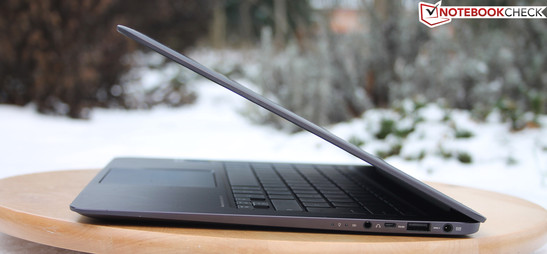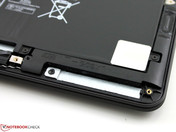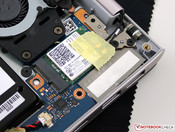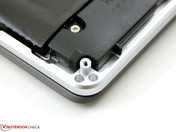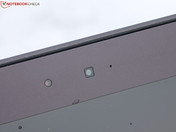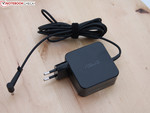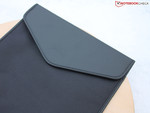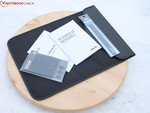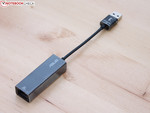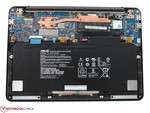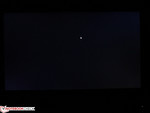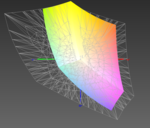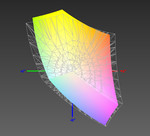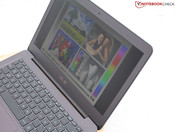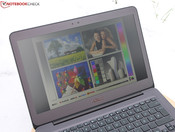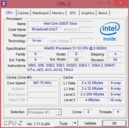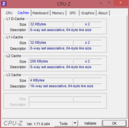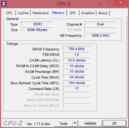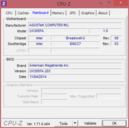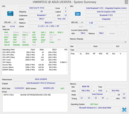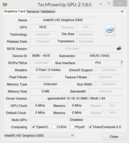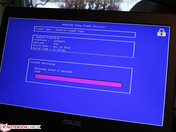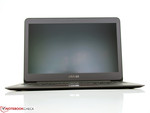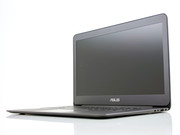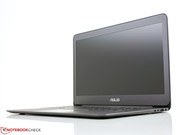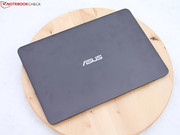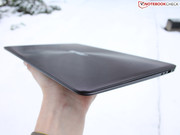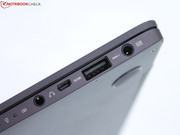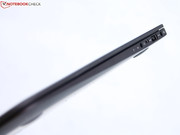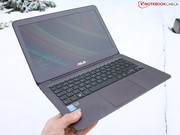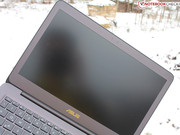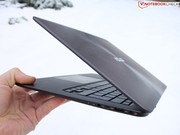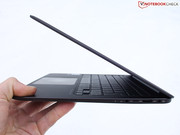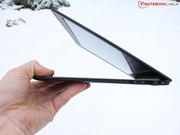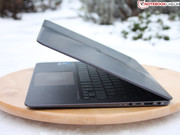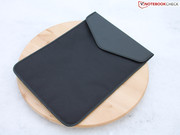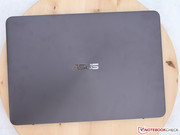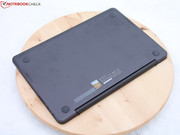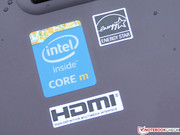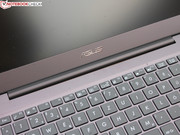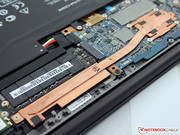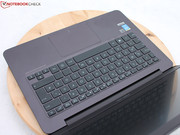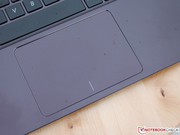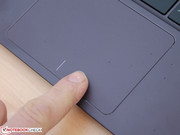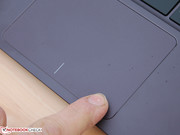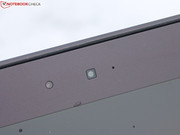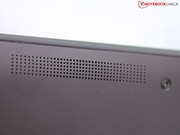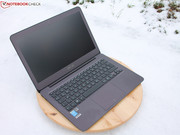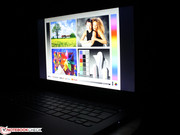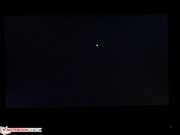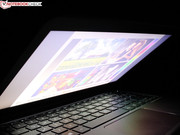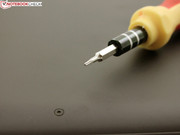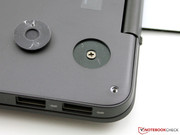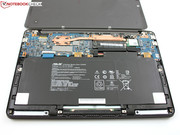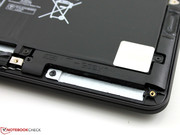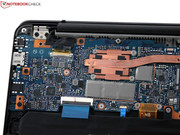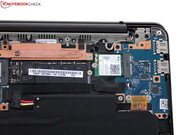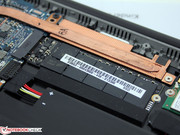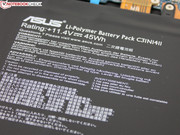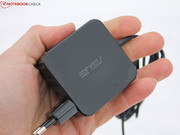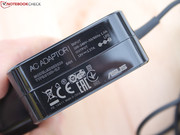Asus Zenbook UX305 Subnotebook Review

For the original German review, see here.
We can't call it an ultrabook; in the end, with our Zenbook UX305FA-FB003H test model, Asus decided on a plain and simple monitor panel. But the word "simple" definitely doesn't apply to the gigantic resolution of 3200x1800 pixels. 4K panels are nothing new, even if they're relatively rare in 13-inch sizes (most recently: Lenovo Yoga 3 Pro). 2560x1440 (3K) and, of course, 1920x1080 (FHD) are more common, which is practically standard in the price class above 700 Euros (~$800).
One novelty is the price range. For 999 Euros (~$1140), the test configuration is equipped with 256 GB of SSD; for 899 Euros (~$1025), the UX305FA-FB006H (90NB06X1-M00060) version has the same 4K panel and 128 GB SSD. Since the flat system processor also has on-board RAM, these resolutions and storage space are also the only configuration variants of the UX305FA. The Full HD version (1920x1080) is also available from 799 Euros (~$911).
The competitors in the form of 13-inch subnotebooks with high resolutions distinguish themselves above all in one way: They are much more expensive than our 999-Euro (~$1140) test configuration Zenbook UX305 with 256 GB and QHD+. Apple's MacBook Pro Retina 13-inch (late 2013) is available from 1,100 Euros (~$1254). As ever, it's the gold standard in terms of case and input device quality. Toshiba's Portege Z30t with matte touch panel also includes a very good IPS panel and has business-class input devices. We chose these two models as direct competitors, which have a relatively affordable entry price in comparison with other similar 13-inch models.
- Apple MacBook Pro Retina 13-inch Late 2013 (2560x1440, Iris 5100, i5-4258U, 1.6 kg, 1,100 Euros, ~$1254)
- Toshiba Portege Z30t-A-10X (1920x1080, HD 4400, i7-4500U, 1.4 kg, 1,100 Euros, ~$1254)
Notably more expensive:
- Toshiba Kira-101 (Kirabook 2014) (2560x1440, HD 4400, i7-4500U, 1.6 kg, 1,400 Euros, ~$1596)
- Dell XPS 13-9333 (1920x1080, HD 4400, i5-4200U, 1.4 kg, 1,300 Euros, ~$1482)
Case
12.3 mm (without stand feet) and 1,267 grams. These are the specs of a subnotebook chassis the likes of which you don't get to hold every day. Even so, it belongs to a mid-range class, which Asus makes clear with the entry-level configuration for 799 Euros (~$911). How does the manufacturer manage to put such a lightweight, high-quality case on the market for just 799 Euros (~$911)? The quantity is one part of the answer, and production of aluminum unibodies has definitely advanced since the first Zenbook, so that these can be manufactured for the mass market more cheaply today.
The base consists of an aluminum block; the keys stick out of it, and the ClickPad is inset. The feet sit on an aluminum plate that envelops the case from below. Asus decided on a simple arrangement with Torx screws, making it easy for users to open the UX305 in order to switch out the battery, WLAN, or SSD modules. This was also the case with earlier Zenbooks.
The inner frame on which the main board lies consists of plastic. The combination of light plastic, a shell of aluminum, and a compact lithium-polymer battery with correspondingly low capacity, offers a lighter weight than the predecessor UX303 (1,438 grams) or the no longer available UX32LN (1,441 grams). The Zenbook UX302LG from late 2013 actually weighed 1,559 grams and was 21 mm tall. Here, Asus has presented a serious advance in slim subnotebooks. Intel's fanless Core M technology is no longer the only entrant here.
The reverse side of the lid is polished in a circle around the logo, and the surface holds up very well under light pressure. The resistance to twisting when the edges are contorted is unusually good, especially considering the thickness of just a few millimeters. This is also nice: when twisting or pressing the reverse side, no pressure points appear on the panel; the liquid crystal seems not to be sensitive to pressure (on the reverse side).
The hinge sits tightly enough on the base and hardly lets the display rock. The lid opens to an angle of up to about 135 degrees. The base can be lifted up very easily at this angle, because the lid slides itself underneath it. To avoid scratches, Asus has included a small spacer on the underside of the lid. The lid can be comfortably opened with one hand, and thanks to the weight of the battery, the base remains on the table. The lid is lightly attached to the base with two magnets. This pull can easily be overcome with one hand, though.
A rubber lip runs around the case, offering a soft, scratch-free connection between base and lid. However, the keyboard is not hermetically closed off; a narrow gap remains to the right and left of the keyboard and the lid has a slight bulge (on both sides).
Connectivity
The low design height doesn't prevent Asus from building in fully functional USB 3.0 ports. This is just as standard in this price class as HDMI (though this comes in the micro variant). At 1280x720 pixels, the webcam's resolution is merely sufficient. Still, we wouldn't make a fuss over it, if photos were are least reliably clear. The focus of the object is indeed good, but surfaces have grainy edges; in terms of color, they are pale and not well differentiated. Asus had to rummage pretty far back in the drawer here.
Things look different with the microphone, which presents no problems with Skype chats. We're not sure if this involves a dual array; Asus provides no information here. The one opening adjacent to the webcam suggests mono, though. In any case, recording works very well; we can stand 0.5 to 3 meters away from the device and speech playback is clear and noiseless. The tone can be quite echoey, though, which also indicates mono input.
Communication
The UX305 has an Intel Dual Band Wireless AC 7265 at its disposal for wireless connection to our WLAN router (Fritz!Box 7490). Theoretically, Wireless AC should double the data flow rate as opposed to Wireless N, since it uses two channels. In the author's individual setting, the Intel chip has rather wide coverage. We were able to surf on notebookcheck.com at the usual speed over a short distance (15 meters / ~50 feet, outside of the building, 4/5 bars). The signal does not break up at distances up to 45 meters (~150 feet). We were able to reach the 45-meter checkpoint with two bars and load notebookcheck with acceptable delays. The predecessor model Zenbook UX303LN didn't make it to 45 meters (Intel Dual Band Wireless AC 7260).
An Ethernet adaptor is not integrated; fortunately, the included USB-to-Ethernet dongle can also be used as a Gigabit adaptor. Until now, the RJ45 dongles provided by Asus were always 10/100 Mbit LAN adaptors (for example, UX303LN). Bluetooth is likewise included. Asus does not offer a 3G variant with modem and SIM-card slot.
Accessories
The accessories consist of a 45-Watt power adapter, the USB-to-Ethernet dongle, a cable tie, the warranty information, and a slim case with Asus branding.
Maintenance
The underside of the UX305 is secured with small screws (Torx/Phillips), two of which are under the rear feet. When these are removed, the following can be accessed by removing the back plate: WLAN module (M.2), SDD (M.2), cooling ribs (in order to clean them), CMOS battery and screwed-in battery. The 8 GB RAM is onboard.
Warranty
The warranty out of the factory adds up to 24 months. Asus will pick up the Zenbook and return it, covering the cost (Collect & Return). The manufacturer only offers warranty extensions for its products with one-year warranties.
Input Devices
Keyboard
Asus puts a chiclet keyboard on the flat keys. The keys are recessed so that they cannot impact the panel while the lid is closed. The stroke is naturally quite brief, but the writer will appreciate the sharp pressure point. Writers who type softly but quickly on the keys will get a firm stroke. The surface has some give, especially in the middle, if the keys are hammered down with force, and the underside of the UX305 presses toward the tabletop. The keys are of an appropriate size and have an excellent layout with offset arrow keys, large Space, Enter, and Shift keys, and FN keys for the usual additional functions (brightness, flight mode, etc.). As is usual with Zenbooks, there is also an FN key on the "A" for activation/deactivation of the ambient light sensor. Unfortunately, the keyboard is not backlit.
Touchpad
The ClickPad, with a diagonal of 12.4 centimeters, is sensitive through the edges and supports the usual multi-touch gestures. The surface is smooth and differentiates itself markedly from the rougher wrist rest. The pad is also inset by just a millimeter, avoiding possible confusion in the darkness. There are no longer separate mouse keys, as is usual with these pads; instead there is just one key under the whole pad. Depending on finger position, the device recognizes whether the user intends a left or right mouse click. Here, around the right mouse key, is just where we experienced difficulty: The key only works when the finger lies far to the right and very near the bottom edge. After the BIOS update to Version 206 (which we did not run only for this reason) and a recovery reinstallation, this weak point was mitigated.
Display
3200x1800 pixels on the TFT of a 13.3-inch model is still something to write home about. The Samsung IPS panel (Model 133YL04 P01) has been coated and is therefore not a touch panel. Purchasers can decide whether the high resolution (276 ppi) is even necessary. Windows can be scaled up without a problem, though this is not true for every program. Even the software for the photo spectrometer, a tool for monitor enthusiasts which implements the color calibration, presents extremely small icons and cut-off measurement results
Our X-Rite i1Pro 2 measures an optimal luminance of 326 cd/m², and because of an even illumination, the average lies just under that at 309 cd/m². Illumination of 80 to 85% is typical, especially with this relatively high brightness. Uniform luminance is definitely a strength of the Asus.
| |||||||||||||||||||||||||
Brightness Distribution: 90 %
Center on Battery: 310 cd/m²
Contrast: 413:1 (Black: 0.75 cd/m²)
ΔE ColorChecker Calman: 2.49 | ∀{0.5-29.43 Ø4.78}
ΔE Greyscale Calman: 1.89 | ∀{0.09-98 Ø5}
83.1% sRGB (Argyll 1.6.3 3D)
54% AdobeRGB 1998 (Argyll 1.6.3 3D)
60.1% AdobeRGB 1998 (Argyll 3D)
83.3% sRGB (Argyll 3D)
58.2% Display P3 (Argyll 3D)
Gamma: 2.36
CCT: 6573 K
| Asus ZenBook UX305FA-FB003H IPS matt 3200x1800 | Apple MacBook Pro Retina 13 inch 2013-10 IPS glare 2560x1440 | Toshiba Portege Z30t-A-10X IPS matt 1920x1080 | Toshiba Kirabook 2014 IPS glare 2560x1440 | Dell XPS 13-9333 IPS glare 1920x1080 | |
|---|---|---|---|---|---|
| Display | 18% | 11% | 5% | ||
| Display P3 Coverage (%) | 58.2 | 69.6 20% | 64.6 11% | 65.1 12% | |
| sRGB Coverage (%) | 83.3 | 97.3 17% | 94.7 14% | 84.7 2% | |
| AdobeRGB 1998 Coverage (%) | 60.1 | 71.2 18% | 65.5 9% | 61.5 2% | |
| Response Times | |||||
| Response Time Grey 50% / Grey 80% * (ms) | 33 ? | ||||
| Response Time Black / White * (ms) | 26.2 ? | ||||
| PWM Frequency (Hz) | |||||
| Screen | 26% | -38% | 28% | -11% | |
| Brightness middle (cd/m²) | 310 | 327 5% | 312 1% | 227 -27% | 450.1 45% |
| Brightness (cd/m²) | 309 | 300 -3% | 289 -6% | 223 -28% | 441 43% |
| Brightness Distribution (%) | 90 | 84 -7% | 89 -1% | 85 -6% | 92 2% |
| Black Level * (cd/m²) | 0.75 | 0.42 44% | 0.43 43% | 0.166 78% | 0.655 13% |
| Contrast (:1) | 413 | 779 89% | 726 76% | 1367 231% | 687 66% |
| Colorchecker dE 2000 * | 2.49 | 5.64 -127% | 2.5 -0% | 4.53 -82% | |
| Greyscale dE 2000 * | 1.89 | 7.79 -312% | 2.55 -35% | 5.32 -181% | |
| Gamma | 2.36 93% | 2.48 89% | 2.44 90% | 2.35 94% | |
| CCT | 6573 99% | 6161 106% | 6697 97% | 6224 104% | |
| Color Space (Percent of AdobeRGB 1998) (%) | 54 | 64 19% | 61 13% | 55.66 3% | |
| Color Space (Percent of sRGB) (%) | 83.1 | ||||
| Total Average (Program / Settings) | 26% /
26% | -10% /
-23% | 20% /
24% | -3% /
-7% |
* ... smaller is better
Contrast is another story, though. We ran the measurements twice, because we didn't want to believe the low rating of 413:1. It stuck, though, which is why the UX305 lags far behind the competitors when it comes to sharp colors. Color presentation via sRGB is something else entirely; here, the Samsung QHD+ panel hits the color reference exactly. We could not significantly improve the DeltaE of 2.5 and 1.9 (color / grayscale) with any calibrations. Why even bother, with a DeltaE under 3? The human eye can't detect any difference between reference and on-screen color. Still, professionals will have to consider this panel carefully, since neither AdobeRGB1998 nor the smaller sRGB spaces are fully realized. Still, this only seldom works with notebooks.
The panel's brightness is maintained during battery use, but only when the ambient light sensor is turned off. Our photos appear somewhat cloudy. Reflections appear only weakly, and the somewhat faint monitor is still easy to read.
IPS panels usually entail good to very good viewing angles, and the UX305 is no exception. No matter from which position we looked at the screen, color inversions never occurred. From a downward diagonal angle, colors were still marred by a milky film that turned the black surfaces gray, but this did not affect readability.
Performance
The Intel Core M-5Y10 (0.8 GHz + Turbo) is standard for the UX305, and there are no alternatives. While one could choose between Core i7-4510U and Core i5-4210U with Haswell, here there's only a choice between FHD and QHD+ as well as 128 GB vs. 256 GB (raw SSD capacity). 213 GB is available for the user from the M.2 hard drive. The rest is taken up by Windows preinstallation and recovery area. Asus divides the SSD up into OS (95 GB) and data (130 GB) partitions.
The Core M-5Y10 is a dual core SoC of the new Broadwell generation. In terms of performance, it is the weakest horse in a stable of shrunken architecture. Compared to the Haswell predecessors with Y in their names, the Core i5-4210Y (TDP 11.5 Watts, 1.5 to 1.9 GHz) decreased the standard speed but increased the turbo. The TDP sinks to 4.5 Watts due to the lower structural width (14 instead of 22 nm). The Haswell Core i5-4210Y usually had an active fan (Dell XPS 11-9P33), but the built-in Core M-5Y10 doesn't need one. What consequences do the structural shrinking and the energy-saving mania have for the performance in our benchmarks?
Processor
The results show the Core M-5Y10 to be 5 to 15% (multi vs. single) ahead of the 4210Y predecessors (XPS 11). The usual 15-Watt Haswells are markedly higher-performance; the 4500U is at 40%. The Turbo should run at up to 2.0 GHz (single core) in theory, though we could not measure this in our tests. The Cinebench R15 benchmark runs at 2.0 GHz in our single-core test (even running on battery) and at a constant 1.8 GHz in multi-core mode (1.3-1.5 GHz on battery).
In a multi-stress test for the CPU, the level sinks to 1.6-1.7 GHz. The SoC does not manage this while running on battery, though; here the Cinebench R15 Multi measures lower scores (high-performance mode @ 1.3-1.5 GHz, R15 Multi @ 137 instead of 155 points, Single @ 78 instead of 82 points). However, the lower performance while running on battery does not seem to matter in practical use.
| Cinebench R10 | |
| Rendering Single CPUs 64Bit (sort by value) | |
| Asus ZenBook UX305FA-FB003H | |
| Toshiba Portege Z30t-A-10X | |
| Toshiba Kirabook 2014 | |
| Dell XPS 13-9333 | |
| Dell XPS 11 | |
| Rendering Multiple CPUs 64Bit (sort by value) | |
| Asus ZenBook UX305FA-FB003H | |
| Toshiba Portege Z30t-A-10X | |
| Toshiba Kirabook 2014 | |
| Dell XPS 13-9333 | |
| Dell XPS 11 | |
| Octane V2 - Total Score (sort by value) | |
| Asus ZenBook UX305FA-FB003H | |
| Sunspider - 1.0 Total Score (sort by value) | |
| Asus ZenBook UX305FA-FB003H | |
| Apple MacBook Pro Retina 13 inch 2013-10 | |
| Dell XPS 11 | |
| Mozilla Kraken 1.1 - Total (sort by value) | |
| Asus ZenBook UX305FA-FB003H | |
| Apple MacBook Pro Retina 13 inch 2013-10 | |
| Apple MacBook Pro Retina 13 inch 2013-10 | |
| Dell XPS 11 | |
* ... smaller is better
System Performance
PCMarks 7 and 8 measure the usage performance. This is where our UX305 lags noticeably behind, though only in comparison to the high-performance Haswell counterparts. The Dell XPS 11 (Haswell Y) lags 8% behind in PCMark 7's computation score, but the overall score is the same. PCMark doesn't let itself get blinded by fast SSDs; in every test, it shows Haswell Y as having a more or less marginal advantage. The overall performance of the normal ULV models runs up to 20% (depending on the test) ahead of our UX305.
Users may ask whether the UX305 goes to its knees while running 30 to 50 browser tabs or doing a lot of multitasking. This was not the case; we could always skip back and forth between various windows. Meanwhile, a video was running smoothly. Even during simultaneous installation of programs and a copying routine, there were no dropped frames or wait times. Therefore, the experienced performance is in the green zone and quite appropriate for an SSD system.
| PCMark 7 Score | 4001 points | |
| PCMark 8 Home Score Accelerated v2 | 2037 points | |
| PCMark 8 Creative Score Accelerated v2 | 2526 points | |
| PCMark 8 Work Score Accelerated v2 | 2761 points | |
Help | ||
Storage Devices
The SanDisk 256 GB SSD (model SD7SN3Q256G1002) is installed as an M.2 module (full size). Its data transfer rates consistently sit at the same level as those of its counterparts; no surprises here. We did not run this test on the MacBook Pro Retina 13.
| Asus ZenBook UX305FA-FB003H HD Graphics 5300, 5Y10, SanDisk SD7SN3Q256G1002 | Toshiba Portege Z30t-A-10X HD Graphics 4400, 4500U, Toshiba HG6 THNSNJ256GMCU | Toshiba Kirabook 2014 HD Graphics 4400, 4500U, Toshiba THNSNJ256GMCT | Dell XPS 13-9333 HD Graphics 4400, 4200U, Liteonit LMT-128M6M | |
|---|---|---|---|---|
| AS SSD | -1% | 15% | -1% | |
| Score Total (Points) | 928 | 930 0% | 972 5% | 902 -3% |
| Score Read (Points) | 411 | 427 4% | 431 5% | 373 -9% |
| Score Write (Points) | 301 | 282 -6% | 318 6% | 337 12% |
| Copy Program MB/s (MB/s) | 138.7 | 92.7 -33% | 209.8 51% | |
| 4K Read (MB/s) | 28.11 | 21.11 -25% | 21.22 -25% | 29.32 4% |
| 4K Write (MB/s) | 59.4 | 68.8 16% | 83.5 41% | 57.6 -3% |
| Seq Read (MB/s) | 454.5 | 511 12% | 512 13% | 492.7 8% |
| Seq Write (MB/s) | 371.6 | 457.9 23% | 457.4 23% | 302.2 -19% |
Graphics Card
The Intel HD Graphics 5300 is integrated into the SoC and supports the processor with DirectX 11.2 API, likewise with OpenCL 1.3/2.0 and OpenGL 4.3. The maximum processor speed of 800 MHz is never reached. The Cinebench R15 shading test is performed at 449 to 549 MHz. The comparison with the HD Graphics 4200 comes out looking good; the HD 5300 can pack on up to 40% (Cloud Gate Graphics). This lies at least in part with the storage connection via dual channel. An HD 4400 (Haswell 15 Watt) can overtake the HD 5300 by 40 to 60%.
| 3DMark | |
| 1280x720 Cloud Gate Standard Score (sort by value) | |
| Asus ZenBook UX305FA-FB003H | |
| Toshiba Portege Z30t-A-10X | |
| Toshiba Kirabook 2014 | |
| Dell XPS 11 | |
| 1280x720 Cloud Gate Standard Graphics (sort by value) | |
| Asus ZenBook UX305FA-FB003H | |
| Toshiba Portege Z30t-A-10X | |
| Toshiba Kirabook 2014 | |
| Dell XPS 11 | |
| 1920x1080 Fire Strike Score (sort by value) | |
| Asus ZenBook UX305FA-FB003H | |
| Toshiba Portege Z30t-A-10X | |
| Toshiba Kirabook 2014 | |
| Dell XPS 11 | |
| 1920x1080 Fire Strike Graphics (sort by value) | |
| Asus ZenBook UX305FA-FB003H | |
| Toshiba Portege Z30t-A-10X | |
| Toshiba Kirabook 2014 | |
| Dell XPS 11 | |
| 3DMark 11 Performance | 686 points | |
| 3DMark Ice Storm Standard Score | 27325 points | |
| 3DMark Cloud Gate Standard Score | 2958 points | |
| 3DMark Fire Strike Score | 407 points | |
Help | ||
Gaming Performance
The UX305 does not distinguish itself for gamers, though, even with older titles like Anno 2070 or Risen, Part 1. Haswell Y is similarly poor for this discipline, and an HD 4400 even with an advantage of 18 to 28% over this low level, does not reach playable frame rates either. As an alternative to a Zenbook UX303LN a GeForce 840M could be used instead.
| Anno 2070 | |
| 1366x768 Medium Preset AA:on (sort by value) | |
| Asus ZenBook UX305FA-FB003H | |
| Toshiba Portege Z30t-A-10X | |
| Dell XPS 11 | |
| 1366x768 High Preset AA:on AF:2x (sort by value) | |
| Asus ZenBook UX305FA-FB003H | |
| Toshiba Portege Z30t-A-10X | |
| Dell XPS 11 | |
| low | med. | high | ultra | |
|---|---|---|---|---|
| Risen (2009) | 20.3 | 14.5 | ||
| Anno 2070 (2011) | 19.5 | 11.6 | ||
| Middle-earth: Shadow of Mordor (2014) | 14.2 | 4.7 |
Emissions
Temperature
In idle mode, the base doesn't even reach the temperature of the hands; even in the middle of the chassis, where the cooling ribs are found, we could feel the warmth with our hands. We used the stress test from Prime95 and Furmark in order to create the highest possible steady load. As expected, the CPU cycles back to 800 MHz, where it stays constant. The GPU reduces itself to 400 MHz, which lies only a bit under its previous 450-550 MHz level (during the Cinebench R15 shading benchmark). Now the upper surfaces heat up noticeably; we measured up to 43 °C (109 °F). For a fanless design, this is a fairly low high-water mark.
The Kirabook 2014 with fan stayed around 40 °C (104 °F) during this test, while the MacBook Pro Retina 13 (fan) reached 43 °C (109 °F). The Core M really has an advantage here in terms of warming, which is not hindered by its noiselessness.
| Asus ZenBook UX305FA-FB003H HD Graphics 5300, 5Y10, SanDisk SD7SN3Q256G1002 | Apple MacBook Pro Retina 13 inch 2013-10 Iris Graphics 5100, 4258U, Apple SSD SM0256F | Toshiba Portege Z30t-A-10X HD Graphics 4400, 4500U, Toshiba HG6 THNSNJ256GMCU | Toshiba Kirabook 2014 HD Graphics 4400, 4500U, Toshiba THNSNJ256GMCT | Dell XPS 13-9333 HD Graphics 4400, 4200U, Liteonit LMT-128M6M | Dell XPS 11 HD Graphics 4200, 4210Y, Samsung SSD PM841 MZMTD256HAGM | |
|---|---|---|---|---|---|---|
| Heat | -4% | -9% | 7% | -20% | -6% | |
| Maximum Upper Side * (°C) | 43.1 | 43 -0% | 39 10% | 40.3 6% | 44.2 -3% | 36 16% |
| Maximum Bottom * (°C) | 41.2 | 40 3% | 37.2 10% | 34.1 17% | 48.4 -17% | 39.7 4% |
| Idle Upper Side * (°C) | 26.3 | 29 -10% | 34.3 -30% | 25.8 2% | 32.6 -24% | 30.9 -17% |
| Idle Bottom * (°C) | 26.2 | 28 -7% | 33 -26% | 26 1% | 35.8 -37% | 33.2 -27% |
* ... smaller is better
(±) The maximum temperature on the upper side is 43.1 °C / 110 F, compared to the average of 35.9 °C / 97 F, ranging from 21.4 to 59 °C for the class Subnotebook.
(±) The bottom heats up to a maximum of 41.2 °C / 106 F, compared to the average of 39.3 °C / 103 F
(+) In idle usage, the average temperature for the upper side is 24.2 °C / 76 F, compared to the device average of 30.8 °C / 87 F.
(+) The palmrests and touchpad are cooler than skin temperature with a maximum of 30.1 °C / 86.2 F and are therefore cool to the touch.
(±) The average temperature of the palmrest area of similar devices was 28.2 °C / 82.8 F (-1.9 °C / -3.4 F).
Speakers
The noise of the speakers is thin; lows and differentiated highs are absent. The Audio Wizard changes the pitches and auditory source width, but music can't really be played at listening quality even in Music Mode.
Neither the middle nor high ranges can shine with a clear, voluminous, well-balanced playback; nor the bass range with recognizable lows. What we don't like goes beyond the rudimentary standard of a 08/15 notebook. The upper volume reserves are good enough to fill a mid-sized room (30 m²). It doesn't sound particularly pretty, though; the small speakers are easily overwhelmed. The user's only option is pretty much to use external speakers (via HDMI or microphone jack).
Energy Management
Power Consumption
The power consumption in idle mode isn't significantly different from Haswell competitors. The variation in idle maximum is mostly influenced by panel brightness, so the display of the frugal Kirabook 2014 (7.6 Watts) shines at just 222 cd/m² and not 309 cd/m² (UX305, 8.6 Watts). The Dell XPS 11 with the predecessor Core i5-4210Y has an identical power consumption profile but a smaller display diagonal; therefore its power consumption must be considered somewhat higher. The Haswell Y's consumption under load is noticeably lower than that of the UX305, which is why the battery life comparison remains interesting.
Under load, there are hardly any differences between the Haswell 15-Watt and the Core M. One exception: the MacBook Pro Retina 13, thanks to a strong, integrated Intel Iris Graphics 5100.
| Asus ZenBook UX305FA-FB003H M-5Y10 | Apple MacBook Pro Retina 13 inch 2013-10 i5-4258U | Toshiba Portege Z30t-A-10X i7-4500U | Toshiba Kirabook 2014 i7-4500U | Dell XPS 11 i5-4200U | |
|---|---|---|---|---|---|
| Power Consumption | -48% | 3% | 5% | 17% | |
| Idle Minimum * (Watt) | 3.1 | 2.8 10% | 3 3% | 3.3 -6% | 3.1 -0% |
| Idle Average * (Watt) | 7.5 | 8.8 -17% | 6.6 12% | 5.6 25% | 7.4 1% |
| Idle Maximum * (Watt) | 8.6 | 9 -5% | 7.9 8% | 7.6 12% | 7.4 14% |
| Load Average * (Watt) | 25.2 | 58 -130% | 27.4 -9% | 28.8 -14% | 17.2 32% |
| Load Maximum * (Watt) | 30.6 | 60.6 -98% | 30.3 1% | 28.9 6% | 19 38% |
* ... smaller is better
| Off / Standby | |
| Idle | |
| Load |
|
Key:
min: | |
Battery Life
As we established above, the Core M offers no improvements in terms of performance in comparison with the Haswell (ULV 15 Watt); only the 11.5-Watt Y models are easily surpassed. Hope therefore lies with the battery life. Does the lower power consumption lead to noticeably longer runtimes?
The "Core M = more battery life" equation does not quite balance out, as the graph below shows. With a correspondingly low capacity of just 45 Wh, the UX305 manages barely seven hours in our WLAN test or 13 hours in idle mode with lowest brightness. The Kirabook 2014 performs at about the same runtime with 52 Wh; the Z30t (52 Wh) improves upon this by a whole hour with its higher-performance SoC. The MacBook Pro Retina 13 isn't a good comparison with its 72 Wh; it lasts longer by three hours in our WLAN test.
The battery life under load is similar to that of the Portege Z30t-A-10X but an hour better than that of the Kirabook 2014.
| Asus ZenBook UX305FA-FB003H M-5Y10 45Wh | Apple MacBook Pro Retina 13 inch 2013-10 i5 4258U 72Wh | Toshiba Portege Z30t-A-10X i7 4500U 52Wh | Toshiba Kirabook 2014 i7 4500U 52Wh | Dell XPS 13-9333 i5 4200U 55Wh | Dell XPS 11 HD Graphics 4200, 4210Y, Samsung SSD PM841 MZMTD256HAGM | |
|---|---|---|---|---|---|---|
| Battery runtime | 27% | 15% | -9% | 18% | -20% | |
| Reader / Idle (h) | 13 | 25.6 97% | 19.9 53% | 13.9 7% | 16.5 27% | 10.3 -21% |
| H.264 (h) | 6.6 | 7.8 18% | 6.5 -2% | 6.2 -6% | 5.6 -15% | |
| WiFi (h) | 6.8 | 9.5 40% | 7.9 16% | 6.6 -3% | 7.8 15% | 6.3 -7% |
| Load (h) | 3.2 | 1.7 -47% | 3 -6% | 2.1 -34% | 3.6 13% | 2 -37% |
Verdict
The Zenbook UX305FA has a number of highlights in terms of workmanship, ergonomics, display, and keyboard. In view of its specialization for the longest possible battery life, the Core M doesn't impress us, since we are used to similarly long times from Haswell. So why go for a Core M and not a now-cheaper Haswell? In favor of the Core M: the fanless design and the light weight of the machine. For similar battery life times, Asus could build in a lighter battery with lower capacity. The verdict for battery life is still disappointing: just seven hours in WLAN testing isn't really that bad, but Haswell competitors with their higher-performance processors can do it too (except for the i5-4210Y).
Apart from the question of whether the Core M is an advantage or not, the UX305 seems to us to be a well-balanced subnotebook that has much to offer for professional users and demanding private users alike. Most users aren't performance enthusiasts that select their notebooks according to benchmark criteria.
The light, stable 13-inch device sits well in the hand; the upper surfaces feel substantial. The keyboard has excellent feedback, appropriate for users who write a lot. Unfortunately, the keyboard is not backlit. With the display, we see a mania for enormousness (QHD+/4K) and weak contrast (413:1) side by side. The advantages, such as uniform, high brightness, excellent color reproduction in factory condition, and lack of reflection, more than balance out the disadvantages.
The competitors aren't out of the running (see shortcut "the competition," right), even if their prices are all higher. Apple's MacBook Pro Retina 13-inch and Toshiba's Portege Z30t-A-10X are definitely worth a look because of their not-dissimilar prices (each 1100 Euros, ~$1254). In view of the FHD entry-level variant at 800 Euros (~$911), the Zenbook UX305FA remains undefeated as the most affordable option.




